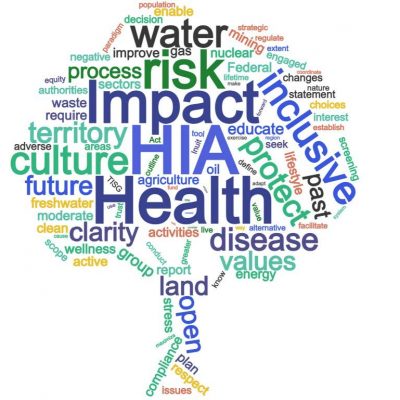Health Impact Assessment in Canada’s Impact Assessment Process
Introduction
The new Canadian federal Impact Assessment Act requires that human health be assessed by employing the “best practices in Health Impact Assessment methods” for federally designated projects. As such, under the new Impact Assessment (IA) process, there is a greater focus on assessing the potential impacts on human health and well-being. The new requirements extend beyond past scopes of work for conducting health assessments for project applications.
Impact Assessment Process
As part of the Planning Phase of the IA process, the Impact Assessment Agency of Canada (IAAC) prepares Tailored Impact Statement Guidelines (TISG) for designated projects. The TISG are an important element of the IA process, and provide the proponent with direction and the requirements for the Impact Statement, which includes an assessment of human health. During the Impact Statement Phase, a Health Impact Assessment (HIA) is conducted alongside (and relies on) other IA study streams, such as the air quality assessment, water quality assessment, noise study, human health risk assessment, and socio-economic impact assessment. From the Planning Phase onwards, engaging with potentially affected stakeholders and rights holders (Indigenous peoples of Canada) is a key aspect of the IA Process, including the HIA.
Prior to the new Impact Assessment Act, health was typically evaluated through an environmental risk assessment process. That process limits the assessment to changes in environmental quality and the consequent risks to human health.
Health Impact Assessment
The World Health Organization (WHO) defines health as “a state of complete physical, mental and social well-being and not merely the absence of disease or infirmity”. This definition is considered an ideal to strive for, and it forms the principle upon which HIA is based. Historically, the consideration of community health has been restricted to an evaluation of health impacts associated with environmental contaminants.
Under the IA process, HIA evaluates both the potential positive and negative health impacts of federally designated projects. It is complementary to existing risk assessment and environmental/impact assessment processes, and evaluates health, not only from the perspective of environmental exposure to chemicals in the built and natural environments, but also in terms of various determinants of health such as social, cultural, spiritual, economic, mental well-being, and physical factors.
An HIA typically consists of a series of phases that are intended to provide a framework around which a health assessment is conducted. Although guidance documents from around the world have slight variations on these steps, the process is fundamentally the same (see below, adapted from World Health Organization).

The initial stages of the work involve a screening process to determine the need for an HIA, followed by a Scoping Phase to plan the HIA and identify the applicable determinants of health to include in the assessment (the “blueprint” for the assessment).
The Assessment Phase evaluates and characterizes health impacts for each health issue (determinant) identified during the Scoping Phase. Based on the findings of the assessment, recommendations can be made for each of the health issues. HIA recommendations are made with the understanding that the mitigation strategies within the Impact Statement will be implemented. Ideally, recommendations should incorporate input from rightsholders and stakeholders and subject matter experts.
Ultimately, the goal of the HIA is to minimize the negative impacts and maximize the positive impacts of the determinants of health by recommending mitigation and enhancement measures for the proposed project.
How can Intrinsik help?
Intrinsik has successfully applied its HIA approach for projects in Canada and the United States. Please contact us at if you would like to find out more about the process and what the new federal requirements may mean for your project.

